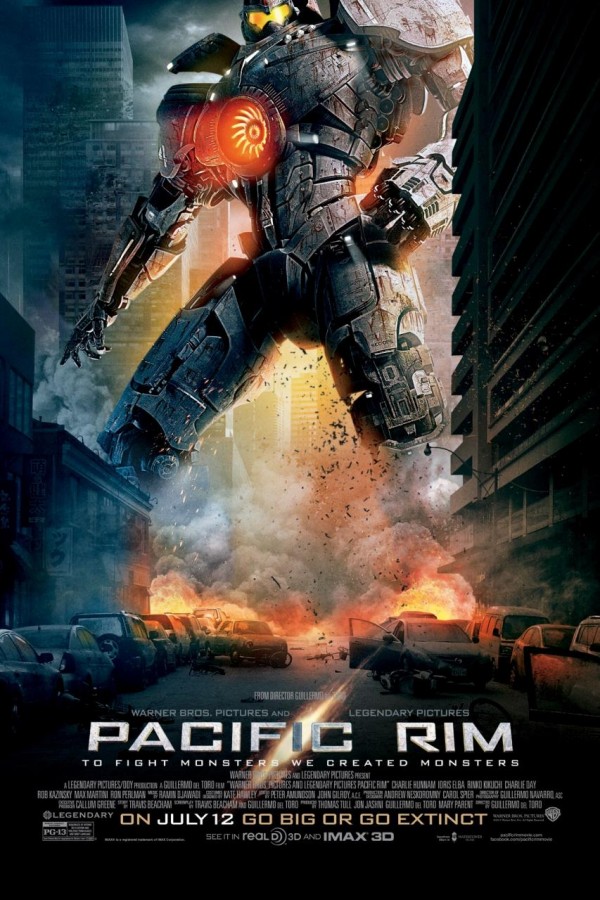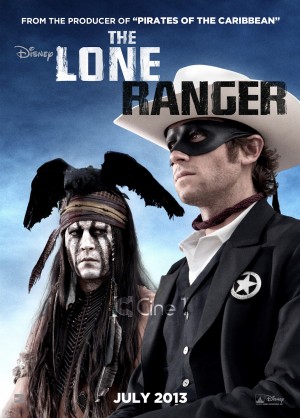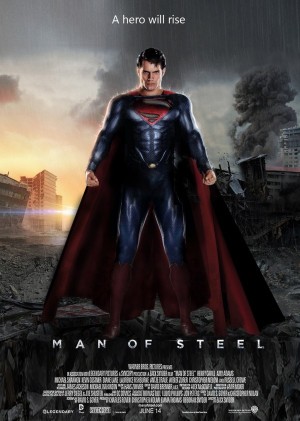
PACIFIC RIM (2013, directed by Guillermo del Toro, 132 minutes, U.S.)
THE LONE RANGER (2013, directed by Gore Verbinski, 149 minutes, U.S.)
MAN OF STEEL (2013, directed by Zack Snyder, 143 minutes, U.S.)
 BY DAN BUSKIRK FILM CRITIC There is a cultural belief that often goes unexamined that says the quality of the arts in this country is a constant: bad songs were always on the radio, TV has always been stupid and Hollywood has always made big budget fluff. It’s a naive viewpoint, history shows that art thrives and wilts according to all sorts of economic and cultural pressures. The three films I’ve seen over the last week all bear the imprints of the current corporate franchise-driven culture of Hollywood film and like a lot of other American institutions, things are seriously out of whack. Art and commerce have always danced awkwardly in Hollywood, but more and more frequently it is creating a cinema where demands of commerce shape and strangle the basic humanity at the center of all storytelling.
BY DAN BUSKIRK FILM CRITIC There is a cultural belief that often goes unexamined that says the quality of the arts in this country is a constant: bad songs were always on the radio, TV has always been stupid and Hollywood has always made big budget fluff. It’s a naive viewpoint, history shows that art thrives and wilts according to all sorts of economic and cultural pressures. The three films I’ve seen over the last week all bear the imprints of the current corporate franchise-driven culture of Hollywood film and like a lot of other American institutions, things are seriously out of whack. Art and commerce have always danced awkwardly in Hollywood, but more and more frequently it is creating a cinema where demands of commerce shape and strangle the basic humanity at the center of all storytelling.
There’s a master’s course to be taught on the recent reanimation of the Lone Ranger, an idea that seems highly-questionable at its inception. While everyone is familiar with “Heigh-Ho Silver” how many film goers today have an emotional affection for the character, who began on radio in the 1930s and moved to television during the medium’s early days? Not letting the ghosts of Jonah Hex and Cowboys and Alien dissuade them, director Gore Verbinski and Johnny Depp have reunited hoping to catch the magic (i.e. money) of Pirates of the Caribbean a second time with a hugely-budgeted grand scale Western. The coming together of this deal, hatched more by commerce than inspiration, is the real Lone Ranger origin story here.
On screen the cowboy’s origin is another story, and it is a mess of bombast, misplaced comedy, grisly violence, and a needlessly intricate plot that flails wildly to its conclusion. It’s as if  the producers thought the best way to make a meal was to ask everyone what their favorite ingredient was and then to mix them all together for a cattle drive stew. What tastes worst? Well, you could start with Depp’s Tonto, who comes to life in a museum diorama and precedes to give a performance that recalls Indian characters from the beginning of the sound age, talking in the husky “Big Chief need wampum” cadences of Native Americans in Bugs Bunny cartoons. Depp is front and center and Armie Hammer’s Lone Ranger seems designed not to upstage the star. Hammer has the jaw and the stature for the job but as the character is written here, he’s a bit of a prissy, bumbling fool, whose strength comes from the fact that Tonto has proclaimed him a “Spirit Walker” who cannot be killed. (Hammer’s leading man status is still-unproven and highly suspect, however he seems perfectly suited for the guy who doesn’t get the girl in romantic comedies.) Together Tonto and The Masked Man hunt for Butch Cavendish (William Fichtner, exhibiting a Tarantino vibe) who is responsible for the Ranger’s brother’s death and may be a supernatural devil called “the wendigo.”
the producers thought the best way to make a meal was to ask everyone what their favorite ingredient was and then to mix them all together for a cattle drive stew. What tastes worst? Well, you could start with Depp’s Tonto, who comes to life in a museum diorama and precedes to give a performance that recalls Indian characters from the beginning of the sound age, talking in the husky “Big Chief need wampum” cadences of Native Americans in Bugs Bunny cartoons. Depp is front and center and Armie Hammer’s Lone Ranger seems designed not to upstage the star. Hammer has the jaw and the stature for the job but as the character is written here, he’s a bit of a prissy, bumbling fool, whose strength comes from the fact that Tonto has proclaimed him a “Spirit Walker” who cannot be killed. (Hammer’s leading man status is still-unproven and highly suspect, however he seems perfectly suited for the guy who doesn’t get the girl in romantic comedies.) Together Tonto and The Masked Man hunt for Butch Cavendish (William Fichtner, exhibiting a Tarantino vibe) who is responsible for the Ranger’s brother’s death and may be a supernatural devil called “the wendigo.”
(Little but telling things that bother me? There’s a scene were Armie Hammer’s stunt double slides down a banister onto the back of the galloping Silver. A typical western stunt, but here the camera cuts just after the slide to a shot the stunt man landing on the horse, never letting us see the stunt being completed. You had $250 million to blow and you couldn’t stage even that tiny spectacle?)
The Lone Ranger‘s script was concocted by a trio of writers, with the pair who wrote all those overblown Pirates sequels among the responsible, and its plotting seems like an afterthought to threading the planned actions sequences together. Even at two and a half hours, the film’s pacing allows little time for basic characterization. For example, the Ranger’s unconsummated romance with his brother’s widow Rebecca (Ruth Wilson) isn’t allotted more than a fleeting expository scene together, leaving all those heart-pounding rescue scenes coolly inert. Meanwhile, it is Tonto and the Ranger running from one suspense scene to the next, with not a surprising moment to be found anywhere along the trail. The action scenes themselves are manic and the characters’ actions so beyond belief that the sense of danger disappears because anything in the CGI toolkit seems possible (if a horse can jump from the second story roof with two men on its back and never break stride, what can’t happen?) Of course this is supposed to lay the groundwork for franchise heaven but seems unlikely that anyone leaves The Lone Ranger yearning for more. By its long-drawn finale, The Lone Ranger ends up delivering the summery feeling of losing a hot dog eating contest.
– – – – – – – – – –
More franchise-baiting is afoot in Man of Steel, where the Orphan of Krypton placed in the hands of Zach Snyder, presumably because of the ho-hum work he did directing the film version of The Watchmen. In 2006 there was a stillborn attempt to get the Superman franchise a-flying, but now they’ve started over with screenwriters Christopher Nolan and David S. Goyer brought in from their success with the Batman Dark Knight series. Too-predictably, Superman now suffers from the plague of the modern screen super hero, a malady called “crippling angst.” I guess this is the producers attempt to give the hero a contemporary relevance, but is this really the fantasy with which we want to escape the summer heat? Drifting from job to job, tethered to his earthly parents, unsure of his direction, this modern Superman seems to be pandering to the depressive realities of today’s under-employed twentysomethings. Superman as summoned here is a morose character and his humorlessness drains the fun out of the dreadfully heavy proceedings. “Up, Up, and Away” is just another dream deferred.
It is surprising the shadow that is still cast by the 1978 Superman, of all the Superman stories written they’ve decided to revive the General Zod/Phantom Zone saga that began in the ’70s film. Similarly, Henry Cavill’s casting as Superman seems designed to conjure memories of the gentle nature Christopher Reeve brought to the role. After these nostalgic touches and much moping Superman finally confronts Zod (Michael Shannon, to the hilt) in a unimaginative fist fight on the main street of Smallville. There they are, Supes and Zod, going mano-a-mano on the little old-fashioned main street of Smallville, only the little Mom and Pop stores have been replaced by a Sears, and U-Haul and a 7-11. Will Superman protect the low-paying chain store jobs of the Midwest? “Not the Slurpee machine!” Never have Superman’s triumphs seemed so empty.
The bloodless destruction porn wreaked on Metropolis, ending with capital punishment that Supes doles out to the film’s villain seems out-of-step as well, leaving a lingering pall over the character and the story. Where the character was once a symbol of America’s melting pot, morality, and can-do spirit, Nolan and Snyder’s Superman is alienated from the American people and its government, making the character more isolated an unknowable than ever. I’m not sure whose wish is being fulfilled here, Man of Steel makes having super powers seem like a total bummer, and America’s funk is writ large and dull.
– – – – – – – – –
Which brings us to the latest humongous vehicle to hit theaters, Guillermo del Toro’s Pacific Rim. Blessedly based on an original story, Pacific Rim‘s subtleties can be encapsulated by the pitch, “Monsters Versus Robots.” In some ways this is a strength, exposition is kept to a minimum, characters are mostly defined by action, and action, action, action is everywhere. If you paid to see giant robots fight monsters, I can assure you, herein lies truth in advertising.
 But is this the best we can expect from writer/director Guillermo del Toro? Pan’s Labyrinth and The Devil’s Backbone and even Hellboy were finely wrought fables, containing allusion and metaphor rich with social and historical ramifications. Pacific Rim on the other hand has less plot than an episode of Power Rangers, with a cast that shows about as much depth. All the easier to translate worldwide, I suppose.
But is this the best we can expect from writer/director Guillermo del Toro? Pan’s Labyrinth and The Devil’s Backbone and even Hellboy were finely wrought fables, containing allusion and metaphor rich with social and historical ramifications. Pacific Rim on the other hand has less plot than an episode of Power Rangers, with a cast that shows about as much depth. All the easier to translate worldwide, I suppose.
The robots (or “Jaegers” as they’re called here, a tribute to test pilot Chuck Yeager, I’m assuming) overwhelm with their convincingly giant scale and watching them fight their monsters brings back fleeting memories of the Japanese tradition of kaiju movies. While less-knotted up in its blockbuster baggage than Lone Ranger or Man of Steel, Pacific Ring is just a savvier take on the modern franchise formula. Its giant robot designs will go far in the videogame market, toys will be marketed, cartoons could be put into production and achieving iconic franchise stature seems almost assured.
But the film’s basic design is made to cater to these marketing realities first. This market-consciousness is apparent right down to the story’s characters, who are a perfectly-cast racial rainbow designed to appeal to every international market yet lacking the cultural details that might alienate them from audiences worldwide. There are no stars here because stars would be too specific, the characters here are designed to be anyone but they’re mostly so bland that they are no one.
If only they worked as hard on bringing the characters to life at the centers of these stories because (with the possible exception of the inarguable star quality Depp brings to the ill-conceived Tonto) every actor and character in these films could effortlessly be swapped out or dropped altogether in the sequel, because you don’t feel a thing for them. Which begs the question, in the Era of Franchise, does humanity even count anymore? The opening weeks are bigger than ever, so I think the industry argument is ‘no, it does not.’ Hollywood doesn’t care who drives the robot in Pacific Rim 5 but by denying that human dimension I wonder if these films will continue to resonate like the ones from past generations. The current mantra is “Concept Is King” but take heart in the fact that kings are made to be toppled, and empires can fall where they once struck back.
